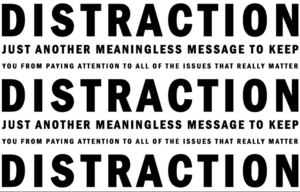Shiny object syndrome can afflict anybody or any organization. Any idea seems brilliant in isolation. In the light of day (or dark of night), shiny objects are distractions from agreed upon, well-crafted strategies. Why are they so attractive?
Today, tomorrow or someday you will feel the glow of shiny object syndrome in your workaday world. You best understand what it is, why it happens and how to handle.
When family or friends talk about how work is going, they often highlight the latest news. They explain what is happening and how it impacts them.
Unfortunately, people’s descriptions frequently sound like they are experiencing shiny object syndrome (I’ll explain below). Intellectual and emotional exhaustion comes through in their story.
Understandably organizations and people (including you) are in search of “it.” Ideas, technologies or methods to help them innovate and grow. Sometimes though they quickly adopt a solution only to abandon at some point.
This is shiny object syndrome.
Let’s take a look. Glasses on!
Shiny Object Syndrome – What The Heck?
So what exactly are we talking about here?
An article by Entrepreneur magazine defines it as follows:
It’s called shiny object syndrome because it’s the equivalent of a small child chasing after shiny objects. Once they get there and see what the object is, they immediately lose interest and start chasing the next thing.
…shiny object syndrome (SOS) is a disease of distraction, and it affects entrepreneurs specifically because of the qualities that make them unique…They crave new technology and new developments. And they aren’t afraid to start new projects and create new things.
While SOS is an affliction for entrepreneurs, it is equally prevalent in corporate environments. Examples of shiny object syndrome include new technologies, marketing approaches and customer service mandates.

Why Does It Matter?
Organizations are looking for increased growth, innovation, operational excellence or customer engagement. While they chart a course to achieve, new ideas emerge all the time.
So what’s the problem, if a technology, strategy, structure or program will work, why not double down?
Shiny object syndrome by definition means attention will fade over time. Switching courses or reprioritizing only to discard is problematic.
Looking for ways to improve is appropriate. Making a left turn toward something that might be better creates a distraction. And distraction is the enemy of execution.
Most important, an organization and its people and customers only have so much capacity. Pulling people to and from shiny objects is exhausting and unproductive. It drains the time, will and in the extreme the credibility of organizations.
Why Does It Happen?
Some people are stylistically pre-disposed to shiny object syndrome. In companies, several factors enable SOS to surface. The conditions include insufficient:
- Agreement on success milestones for strategic initiatives
- Analysis and planning to support successful execution
- Resolve or discipline to stay the course
- Impatience with the speed of success
The underpinning for all of these is uncertainty with a current strategy. Organizations and individuals are under tremendous pressure to perform. Second-guessing about strategy and approach seeps in when something new and polished surfaces. It’s not unnatural, but in a constant state, it’s a concern.

What’s The Difference Between Organizational Change & SOS?
Organizations introduce new approaches and drive change for sound reasons. Adding something new is not synonymous with SOS. Productive organizational changes are well conceived and include background analysis and detailed execution and communication plans.
By contrast, shiny object syndrome ideas come with urgency and in turn less rigor. They displace a previously agreed on plan. And, it’s unclear if the will or ability to execute exist.
Related: How To Communicate Organizational Change So It’s Way Less Painful
How About Shiny Pennies?
OK, so you may hear about shiny pennies. Same thing, different name?
No, not really.
A shiny penny in a business context is:
A new employee joins a department or organization. All the attention and focus is on them until the next bright penny drops.
Shiny pennies are called into every meeting and decision regardless of connection. It’s often a senior person and involves jockeying for favor.
It can be a little painful to watch. Like pennies, the shine mellows and generally people and things find a new normal.
Are You Pushing Shiny Objects?
It could be the broader organization introducing a so-called shiny object. It could be your boss. But it could be you.
Are you dealing any shiny objects to your team or yourself?
If you drive continuous improvement with an eye toward new ideas, shiny objects are a temptation. You want to deliver improved outcomes or grow personally. At the same time, you need to balance existing execution priorities with tempting new approaches.
My affliction with SOS emerges around personal growth interests. I have a topic on which I’m determined to read and learn more. I see or hear another idea and get distracted from what I thought I had committed.
There are so many things to learn! I’m “learning” to commit to less. And I buy less books to help make it less tempting!
Are you executing as planned or are you distracted by other possibilities?
How To Handle – Part 1
First, for decisions you are driving:
- Be super disciplined. Stay the course on well-planned strategies.
- Stay current by finding an appropriate way to process new ideas and approaches. You want to keep learning and growing without letting distractions overtake. Is the best use of time? Will it detract from critical priorities?
- If you consider introducing a new technology, tool or method talk with your team. This readout is essential for many reasons. Also, discuss how to create a work “offset” for your people. You can do this by building a Stop Doing List – here’s how.
- If you change course, plan appropriately, commit to execution and finish.
How To Handle – Part 2
Next, organizational decisions you are dealing with:
This can be tricky depending on who is driving and your view of the new “object.”
- Whether you are 100% in agreement or not, again do your team a favor by considering a Stop Doing List. You give your people the ability to take on more.
- You don’t agree with the decision, in this case, the shiny object, but your belief in the organization is secure. If you find yourself having to carry out a decision you don’t agree with, displaying that isn’t an option. Again, it’s based on a trust of the company and the leadership who made the decision.
- Several strategies articulated by Harvard Business Review’s recent article When You Have To Carry Out A Decision You Disagree With can help including what to do with your reservations:
…the reservations you have about the decision can strengthen the plans you develop with your team. That list of objections you made when convincing yourself the plan is a good one comes in handy here: it reflects your beliefs about the potential obstacles to success. You are already aware of some of the reasons why the plan could fail. Use this list of obstacles to develop contingencies to handle what you think can go wrong.
How To Handle – Part 3
So what if the decision, one more shiny object confirms a lack of trust in the organization?
This realization is more complicated.
You’ll want to give yourself time to process. If you fundamentally don’t trust an organization or the leaders, you need to decide what’s next either internally or externally. A constant state of this isn’t healthy or sustainable.
In the interim, difficult as it may be, you need to stay the course. These become legacy moments.
What do I want people to say about how I handled that?
Glasses Off
So there you have a quick walkthrough on shiny objects be they introduced by you or your organization. They are a reality worth understanding and likely become more prevalent with the accelerated pace of change and tempting technology options.
Balancing an open mind and discipline will help you navigate



